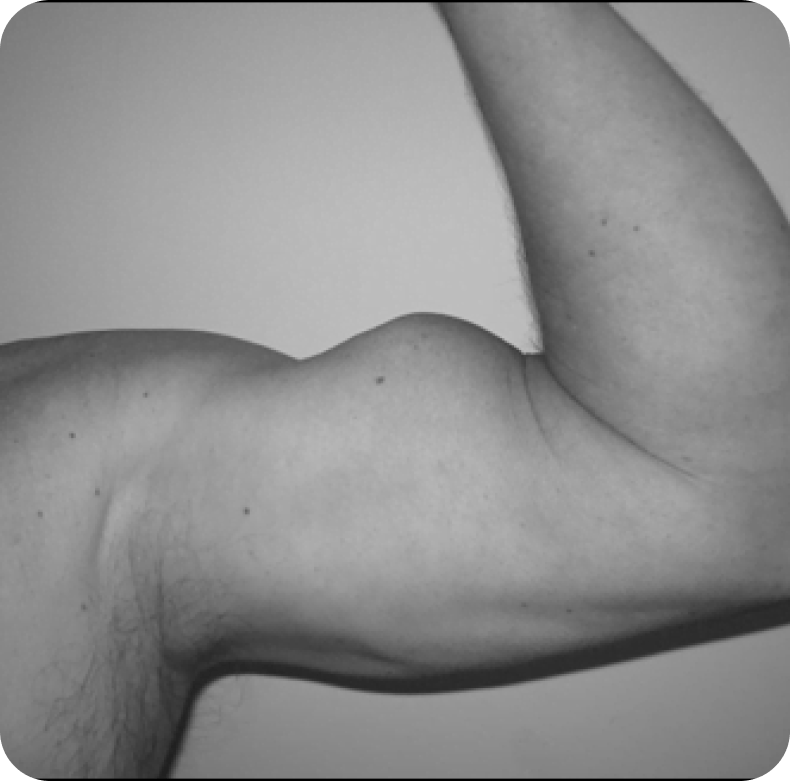Biceps Tear/Pathology
Everything you need to know about your biceps’ anatomy and treatment
Normal
Torn Biceps/Popeye Deformity


Normal

Torn Biceps/Popeye Deformity

How is the bicep fixed?
The type of tear and patients age and activity level play a large role in determining the proper treatment. In general, there are 3 main options if a tear develops.
1. Labral repair: If the biceps is torn at its anchor, this is called a SLAP tear. The labrum can be reattached directly to the glenoid.
2. Biceps Tenodesis: If the tear of the biceps is at the anchor (SLAP tear) or is torn lower in the bicipital groove, a tenodesis can be performed. This is performed by cutting the tendon from its attachment point and relocating it lower in the shoulder, below or within the bicipital groove.
3. Biceps tenotomy: This is performed if the tendon is in very poor condition and is unable to be relocated effectively due to its deterioration.
What is the biceps and how could i have a tear?
Just as a bicycle has two wheels, the biceps has two attachment points in the shoulder (short and long head). Contrary to popular belief, the primary function of the biceps is supination of the forearm rather than flexion. The short head of the biceps attaches to the coracoid and is rarely torn. The lateral aspect of the biceps tendon (long head) travels upward through the intertubercular sulcus and attaches inside the shoulder, to the top of the labrum. The long head is a frequent cause of shoulder pain. A biceps tear can occur at its anchor point (SLAP tear) or within the bicipital groove. Each time our shoulder is moved, the excursion through the groove is significant, and this can lead to tearing. If a SLAP tear develops, this can cause deep shoulder pain. Tearing within the groove can cause pain anteriorly within the shoulder with any type of forward flexion of the shoulder. If a tear develops in the shoulder, come see Dr. Drake at Level Up Shoulder.
Dr. Drake has performed thousands of successful biceps surgeries, won the American Shoulder and Elbow Surgeon’s prestigious Neer Award, graduated the summa cum laude, and has written for major medical journals such as The Journal of Shoulder and Elbow Surgeons. With Dr. Drake, you’ll learn what it means to have a pain-free shoulder in Chicago and the Chicagoland area.

Why we do what we do
Indications you are a candidate to have your biceps fixed
If you match these indications, you may benefit from biceps fixation:
- Intense anterior shoulder pain with elevation of the arm, causing seemingly simple tasks around the house to be difficult.
- Non-surgical or conservative measures have failed to provide pain relief. Treatments such as physical therapy, injections, medications, and alternative methods have failed to give a long-lasting solution.
- Committed to post-surgical rehabilitation.
Recovery and Rehabilitation
After surgery, patients go home on the same day. Upon discharge from the hospital, a sling is recommended for 4 weeks following SLAP repair or biceps tenodesis. If a tenotomy is performed, a sling is not worn unless an additional procedure is performed the same day. Patients are discharged with a short course of pain medication. Ice is recommended for pain relief as well. Early hand and wrist exercises are recommended immediately. Nothing heavy should be placed in the hand and use of the elbow is discouraged.
Follow-up with Dr. Drake’s physician assistant will occur 2 weeks and 4 weeks after the surgery. Physical therapy will start at 4 weeks after surgery. The patient will have follow-ups with Dr. Drake at 3 months and 6 months following the procedure.
Risk and Complications
Biceps surgery has an exceptionally high success rate. It is performed arthroscopically and therefore, complications are rare. If a biceps tenotomy is required or if the biceps fails to heal, a ‘popeye’ deformity of the upper arm can occur. This is mostly cosmetic and not functional. Pain relief is durable. Dr. Drake and his staff are available and should be alerted if there is concern.
